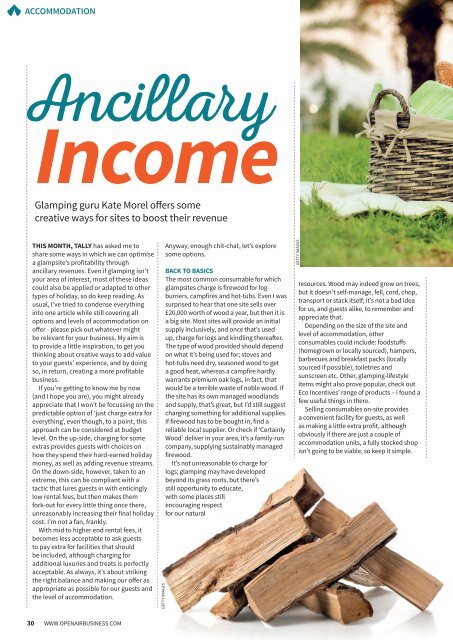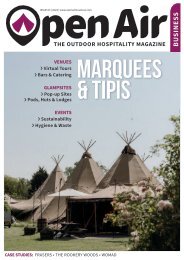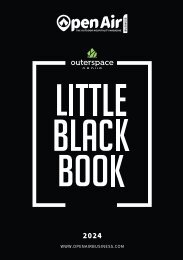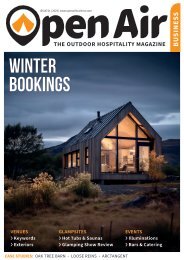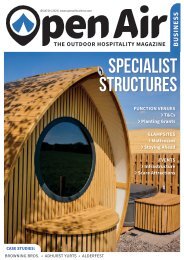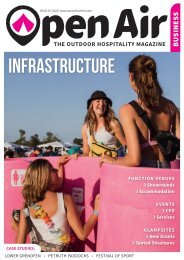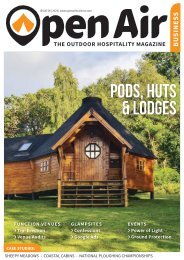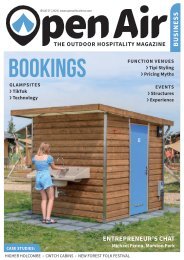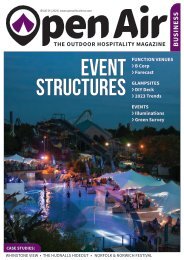Open Air Business March 2017
The UK's outdoor hospitality business magazine for function venues, glamping businesses and outdoor event organisers
The UK's outdoor hospitality business magazine for function venues, glamping businesses and outdoor event organisers
Create successful ePaper yourself
Turn your PDF publications into a flip-book with our unique Google optimized e-Paper software.
ACCOMMODATION<br />
Ancillary<br />
Income<br />
Glamping guru Kate Morel offers some<br />
creative ways for sites to boost their revenue<br />
THIS MONTH, TALLY has asked me to<br />
share some ways in which we can optimise<br />
a glampsite’s profitability through<br />
ancillary revenues. Even if glamping isn’t<br />
your area of interest, most of these ideas<br />
could also be applied or adapted to other<br />
types of holiday, so do keep reading. As<br />
usual, I’ve tried to condense everything<br />
into one article while still covering all<br />
options and levels of accommodation on<br />
offer - please pick out whatever might<br />
be relevant for your business. My aim is<br />
to provide a little inspiration, to get you<br />
thinking about creative ways to add value<br />
to your guests’ experience, and by doing<br />
so, in return, creating a more profitable<br />
business.<br />
If you’re getting to know me by now<br />
(and I hope you are), you might already<br />
appreciate that I won’t be focussing on the<br />
predictable option of ‘just charge extra for<br />
everything’, even though, to a point, this<br />
approach can be considered at budget<br />
level. On the up-side, charging for some<br />
extras provides guests with choices on<br />
how they spend their hard-earned holiday<br />
money, as well as adding revenue streams.<br />
On the down-side, however, taken to an<br />
extreme, this can be compliant with a<br />
tactic that lures guests in with enticingly<br />
low rental fees, but then makes them<br />
fork-out for every little thing once there,<br />
unreasonably increasing their final holiday<br />
cost. I’m not a fan, frankly.<br />
With mid to higher end rental fees, it<br />
becomes less acceptable to ask guests<br />
to pay extra for facilities that should<br />
be included, although charging for<br />
additional luxuries and treats is perfectly<br />
acceptable. As always, it’s about striking<br />
the right balance and making our offer as<br />
appropriate as possible for our guests and<br />
the level of accommodation.<br />
GETTY IMAGES<br />
Anyway, enough chit-chat, let’s explore<br />
some options.<br />
BACK TO BASICS<br />
The most common consumable for which<br />
glampsites charge is firewood for logburners,<br />
campfires and hot-tubs. Even I was<br />
surprised to hear that one site sells over<br />
£20,000 worth of wood a year, but then it is<br />
a big site. Most sites will provide an initial<br />
supply inclusively, and once that’s used<br />
up, charge for logs and kindling thereafter.<br />
The type of wood provided should depend<br />
on what it’s being used for; stoves and<br />
hot-tubs need dry, seasoned wood to get<br />
a good heat, whereas a campfire hardly<br />
warrants premium oak logs, in fact, that<br />
would be a terrible waste of noble wood. If<br />
the site has its own managed woodlands<br />
and supply, that’s great, but I’d still suggest<br />
charging something for additional supplies.<br />
If firewood has to be bought in, find a<br />
reliable local supplier. Or check if ‘Certainly<br />
Wood’ deliver in your area, it’s a family-run<br />
company, supplying sustainably managed<br />
firewood.<br />
It’s not unreasonable to charge for<br />
logs; glamping may have developed<br />
beyond its grass roots, but there’s<br />
still opportunity to educate,<br />
with some places still<br />
encouraging respect<br />
for our natural<br />
GETTY IMAGES<br />
resources. Wood may indeed grow on trees,<br />
but it doesn’t self-manage, fell, cord, chop,<br />
transport or stack itself; it’s not a bad idea<br />
for us, and guests alike, to remember and<br />
appreciate that.<br />
Depending on the size of the site and<br />
level of accommodation, other<br />
consumables could include: foodstuffs<br />
(homegrown or locally sourced), hampers,<br />
barbecues and breakfast packs (locally<br />
sourced if possible), toiletries and<br />
sunscreen etc. Other, glamping-lifestyle<br />
items might also prove popular, check out<br />
Eco Incentives’ range of products – I found a<br />
few useful things in there.<br />
Selling consumables on-site provides<br />
a convenient facility for guests, as well<br />
as making a little extra profit, although<br />
obviously if there are just a couple of<br />
accommodation units, a fully stocked shop<br />
isn’t going to be viable, so keep it simple.<br />
30 WWW.OPENAIRBUSINESS.COM


